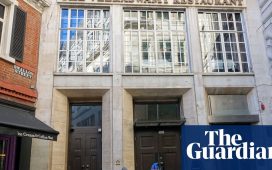Unlock the Editor’s Digest for free
Roula Khalaf, Editor of the FT, selects her favourite stories in this weekly newsletter.
Billions of dollars of debt will fall due this year on hundreds of big US office buildings that their owners are likely to struggle to refinance at current interest rates.
There are $117bn of commercial mortgages tied to offices which either need to be repaid or refinanced in 2024, according to data from the Mortgage Bankers Association.
Many of those were taken out a decade ago in an era when interest rates were far lower. Since then, commercial mortgage rates have nearly doubled, while the performance of many buildings has sunk, raising the prospect of billions of dollars of losses for investors.
“It’s going to be a problem to get some of these refinancings done,” said John Duncan, who heads the real estate finance practice at law firm Polsinelli. “We’re seeing deals where even sophisticated borrowers are calling it a day and asking their lenders whether they would like to take the keys.”
Unlike US home loans, commercial mortgages are almost entirely interest- only. That means developers of large properties tend to have low monthly payments, but face a balloon payment equal to the original loan the day the mortgage comes due.
The expected losses at this point are on a much smaller scale than during the 2008 housing crisis. But soured loans could cause billions in losses for investors, wipe out some property developers — such as the unravelling of Austrian property owner Signa — and lead to forced sales in the already struggling office market. In December, Signa’s insolvency administrator put the company’s ownership of half of New York’s Chrysler Building up for sale in order to raise urgently needed cash.
“We are in the very beginning of trying to weather the office market downturn,” said Richard Hill, the head of real estate strategy at Cohen & Steers. “This is not driven by fundamentals; this has everything to do with financing costs going back up.”
Interest rate expectations have moderated since the start of November, when investors feared inflation was proving stickier than expected and the US Federal Reserve would adopt a policy of “higher for longer”. That has provided a chink of light for some office owners.
Even as investors wait for the Fed to start cutting rates again, refinancings are getting done, eventually. Last month developer Aby Rosen secured a deal for New York’s iconic Seagram building, which stands set back from Park Avenue 10 blocks north of Grand Central station, following months of negotiations and after the $760mn of mortgage debt on the building had already been extended once.
About two-thirds of the soon-to-be due mortgages are held by banks. Delinquencies on those loans — which tend to be backed by higher-quality or lower-leveraged buildings — are rising, but are still very low. Data from the Federal Deposit Insurance Corporation shows it remained at a rate of just 1.5 per cent at the end of the third quarter.
Despite the low default rates, losses on those loans could be significant. In December, a group of US economists found that 40 per cent of office loans on bank balance sheets were under water, potentially causing problem for dozens of regional banks holding them.
“People should realise that regional banks are still very much exposed to the troubles in commercial real estate,” said Leo Huang, head of commercial real estate at Ellington Management.
The rest of the expiring loans on office properties are funded with commercial mortgaged backed securities (CMBS), a type of bond that typically pays more than government debt or similarly rated corporate bonds and are held by insurance companies, pension funds and individual investors.
There are now roughly $800bn in CMBS in the US. Delinquencies on office loans financed by CMBS topped 6 per cent at the end of November, up from 1.7 per cent a year earlier, according to real estate data firm Trepp.
“The CMBS market has done a good job of spreading out the risk,” said Huang. “But that means there will be pain to go around.”
Of the 605 buildings with mortgages expiring soon, there are 224 that Moody’s Analytics estimates owners will have trouble refinancing this year, either because the properties carry too much debt or because their rental performance is poor.
The former Sears Tower in Chicago, the tallest building in the world for more than two decades after its completion in 1974, is one of those on the list.
Now known as the Willis Tower, there is $1.3bn in debt secured against the building due in March. Its recent annual income before interest payments was 7 per cent of its debt. Moody’s predicts that, in light of higher interest rates, owners of buildings not generating at least 9 per cent of their debt in annual income will have trouble refinancing this year.
Although some of the financial troubles of office buildings and their owners are due to the Covid-19 pandemic and the resulting increase in office vacancies, aggressive underwriting in earlier years has also been a factor.
The Seagram building generated $56mn in net operating income in 2012, the year before it refinanced into its current loan. Yet when its lenders underwrote the $760mn mortgage the following year, they estimated the building could bring 30 per cent more a year, or $74mn in annual revenue.
It never has. Profit before interest payments and renovations peaked in 2018 at $69mn, and have fallen since, hitting a low of $27mn in 2022. Since then, Rosen and his firm RFR have added a 35,000-square-foot gym and conference space in the basement, including a 22-foot climbing wall, a multi-sport arena with seating for 150 and a spinning studio.
Even before Rosen secured his refinancing deal last month, brokers said the building remained desirable to tenants and was 92 per cent full as of the middle of the year. But the $54mn in earnings before interest and renovations it was on track to generate for 2023 is about the same amount as in 2012.
“Everyone will blame Covid [for] the losses,” said John Griffin, a professor at Texas university. “But Wall Street’s aggressive underwriting of commercial mortgage debt is going to make the situation a whole lot worse than it would have been.”













